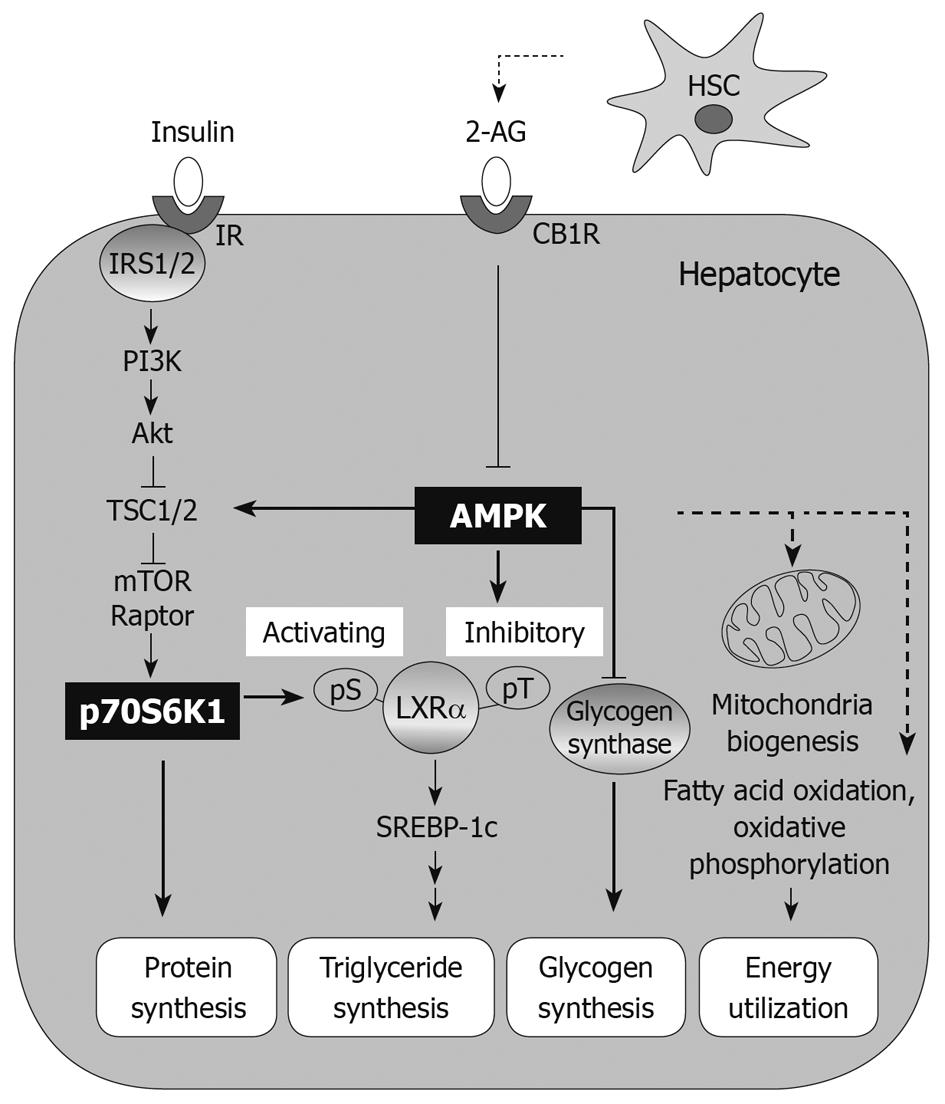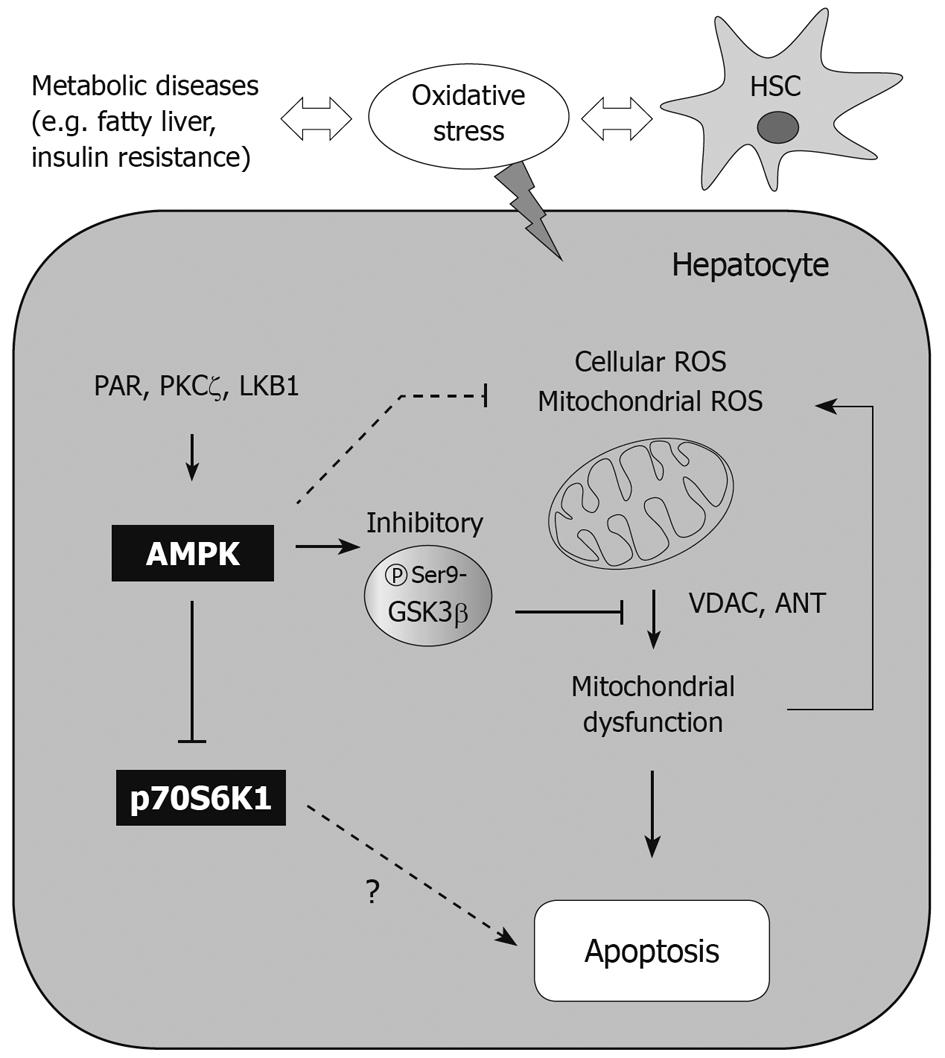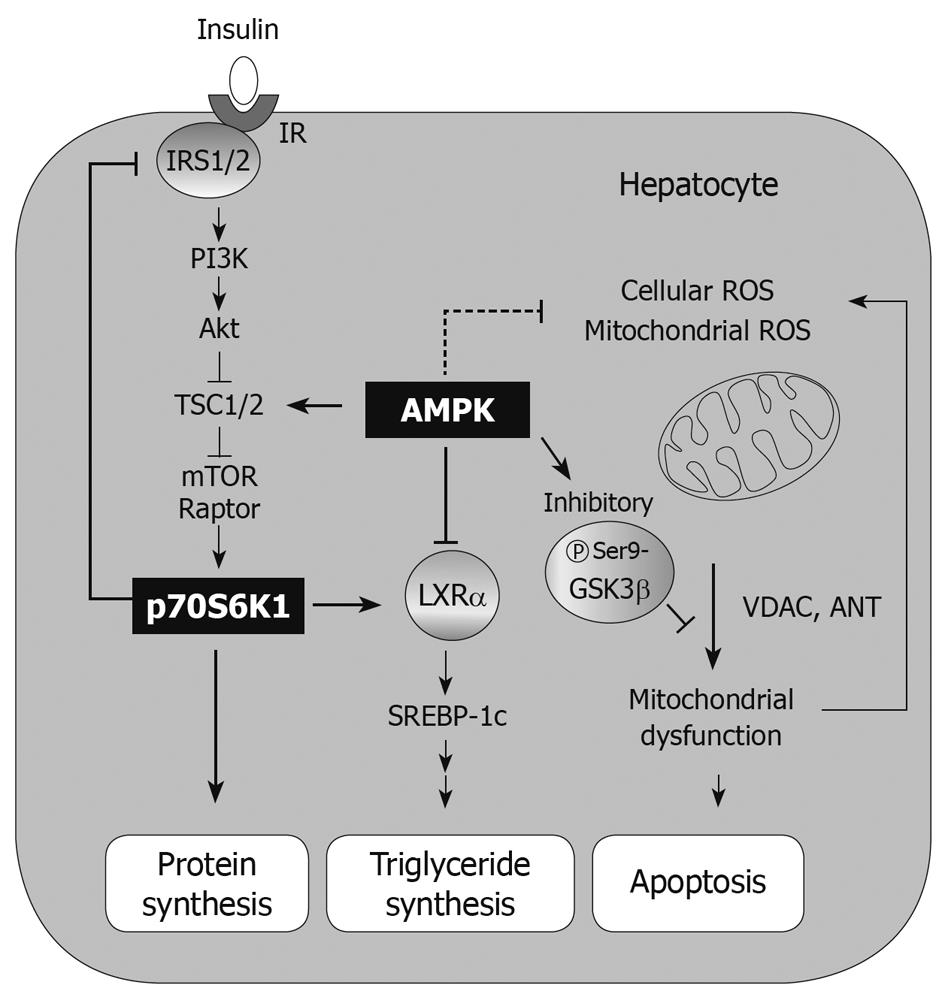Copyright
©2010 Baishideng.
World J Gastroenterol. Aug 14, 2010; 16(30): 3731-3742
Published online Aug 14, 2010. doi: 10.3748/wjg.v16.i30.3731
Published online Aug 14, 2010. doi: 10.3748/wjg.v16.i30.3731
Figure 1 Adenosine monophosphate-activated protein kinase pathway in hepatic fuel metabolism.
Adenosine monophosphate-activated protein kinase (AMPK), a metabolic energy sensor, negatively regulates protein synthesis through inhibition of the mammalian target of rapamycin (mTOR)-S6 kinase-1 (S6K1) pathway. The inhibitory effect of AMPK on liver X receptor-α (LXRα)-dependent triglyceride synthesis is opposed by the action of S6K1. AMPK also shuts down glycogen synthesis via inhibitory phosphorylation of glycogen synthase. AMPK as a fuel sensor induces glucose transport and fat oxidation in response to metabolic stress such as energy deprivation, and also increases mitochondrial biogenesis. AMPK counteracts energy depletion by stimulating energy production and limiting energy utilization. Endocannabinoids such as 2-arachidonoylglycerol derived from hepatic stellate cells decrease AMPK phosphorylation resulting in downregulation of lipogenic action. 2-AG: 2-arachidonoylglycerol; CB1R: Cannabinoid 1 receptor; HSC: Hepatic stellate cell; IR: Insulin receptor; Raptor: Regulatory-associated protein of mTOR; IRS1: Insulin receptor substrate-1; PI3K: Phosphoinositide-3 kinase; TSC1: Tuberous sclerosis complex 1; pS: Phospho-serine; pT: Phospho-threonine; SREBP-1c: Sterol regulatory element binding protein-1c.
Figure 2 Adenosine monophosphate-activated protein kinase regulation of cell viability.
Adenosine monophosphate-activated protein kinase (AMPK) protects cells from oxidative stress-induced H2O2 production and mitochondrial dysfunction, which results in part from the inhibitory phosphorylation of glycogen synthase kinase 3β (GSK3β). GSK3β inhibits mitochondrial function through voltage-activated anion channel (VDAC) phosphorylation. AMPK activation contributed to cell survival, whereas the regulatory role of S6 kinase-1 (S6K1) in apoptosis is still unclear. HSC: Hepatic stellate cell; PAR: Proliferator-activated receptor; PKC: Protein kinase C; LKB1: Liver kinase B1; ROS: Reactive oxygen species; ANT: Adenine nucleotide translocator.
Figure 3 Chemical structures of adenosine monophosphate-activated protein kinase activators.
A: Dithiolethione derivatives: Oltipraz [4-methyl-5-(2-pyrazinyl)-1,2-dithiol-3-thione], CJ11764 (5-pyrazinyl-1,2-dithiole-3-thione), CJ12064 [5-(6-methoxypyrzinyl)-4-methyl-1,2-dithiole-3-thione], CJ11842 (4-methyl-5-phenyl-1,2-dithiole-3-thione), CJ11840 (5-benzo[b]thiophene-3-yl-1,2-dithiole-3-thione), CJ11792 (4,5,6,7-tetrahydrobenzo-1,2-dithiole-3-thione), CJ11788 (5,6-dihydro-4H-cyclopenta-1,2-dithiole-3-thione), CJ11766 (4-ethyl-5-pyrazin-2-yl-1,2-dithiole-3-thione), CJ12073 [5-(6-Ethoxypyrazin-2-yl)-4-methyl-1,2-dithiole-3-thione], CJ11780 (5-methyl-1,2-dithiole-3-thione); B: Metabolites of oltipraz: First, oxidative desulfuration of the thione among approximately 1% of oltipraz to yield M1 [4-methyl-5-(2-pyrazinyl)-1,2-dithiol-3-one], which is not metabolized further; and secondly, desulfuration, methylation, and molecular rearrangement among a large amount of oltipraz to yield M2 [7-methyl-6,8-bis(methylthio)H-pyrrolo(1,2-a)-pyrazine], which is metabolized to other oxidized forms; C: Phytochemicals: Resveratrol (flavonoid found in the skin of red grapes and red wine), isoLQ (a flavonoid aglycone of isoliquiritin from licorice), LQ (a flavonoid aglycone of liquiritin from licorice), sauchinone (a lignan in Saururus chinensis), baicalin (the major flavonoid compound in Scutellaria baicalensis).
Figure 4 Dual regulation of fuel metabolism and cell viability by adenosine monophosphate-activated protein kinase.
The adenosine monophosphate-activated protein kinase (AMPK)-S6 kinase-1 (S6K1) pathway regulates metabolic signaling flow. In addition, AMPK controls the redox-state and mitochondrial function, therefore its activation protects cells from apoptosis. AMPK is the key molecule to bridge the gap between fuel metabolism and hepatocyte viability. IR: Insulin receptor; IRS1: Insulin receptor substrate-1; PI3K: Phosphoinositide-3 kinase; TSC1: Tuberous sclerosis complex 1; ROS: Reactive oxygen species; mTOR: Mammalian target of rapamycin; LXRα: Liver X receptor-α; GSK3β: Glycogen synthase kinase 3β; SREBP-1c: Sterol regulatory element, binding protein-1c; VDAC: Voltage-activated anion channel; ANT: Adenine nucleotide translocator.
- Citation: Yang YM, Han CY, Kim YJ, Kim SG. AMPK-associated signaling to bridge the gap between fuel metabolism and hepatocyte viability. World J Gastroenterol 2010; 16(30): 3731-3742
- URL: https://www.wjgnet.com/1007-9327/full/v16/i30/3731.htm
- DOI: https://dx.doi.org/10.3748/wjg.v16.i30.3731












